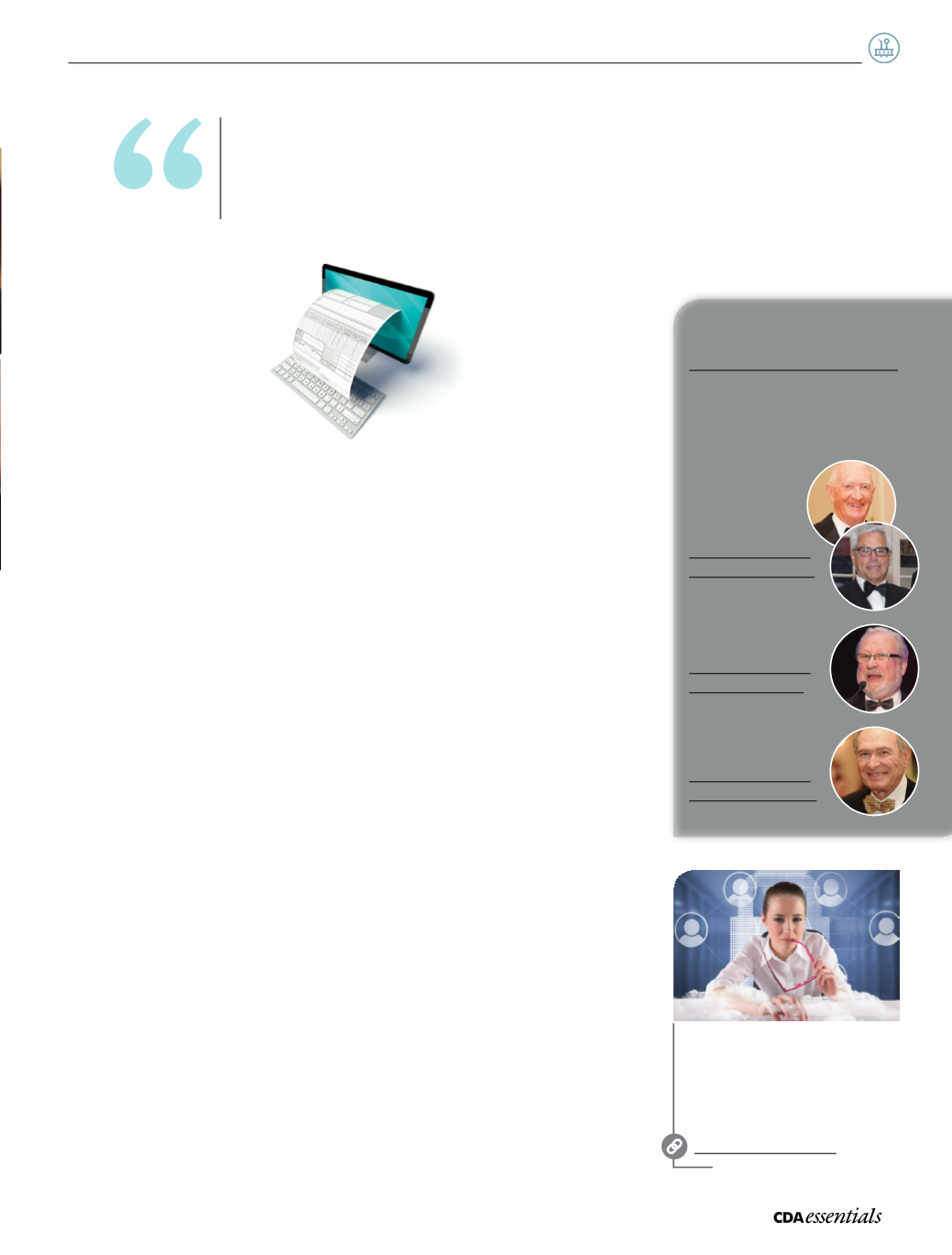
13
Volume3 Issue5
|
CDA
at
W
ork
howmuch theyaccomplishedas
volunteersof theCDAThird-
PartyDental PlansCommittee.
The sacrifices theymade in
theprocesswere significant:
considerable time spent
away from their families and their
practices, andeven lost friendships.
“It’s reallydifficult toconvey just how tense
andemotional thoseyears (of developing
CDAnet)were,” recallsDr. Dolansky,who
describeshis role inCDAnet’s creationas
politician, “arm-twister” andnegotiator.
“Unfortunately, I lost friendshipsover this.
At times, it got tome. I thought, ‘Whyam I
doing this, it’snotworthwhat it’sdoing to
me,my familyandmypractice.’ But I could
never bringmyself toquit.”
“Thenumber of hours thatDrs. Gutkin
andGushue (whobothhad the technical
expertiseneeded toguideCDAnet’s
development) spent away from familyand
out of their practicewasunbelievable,” says
Dr.MacFarlane. “But theenthusiasmand
desire tovolunteerwas trueof everybody
thatworkedon thecommitteeandnot
onlydidweenjoy the fact thatwewere
accomplishing things, butwehadagreat
time together.”
Toappreciate thebarriers facing thisgroup,
it’suseful to remember that the ideaof
CDAnetwas in its infancy in themid-
80s—before the Internet, debit cardsor cell
phonesweremainstream. Dr.MacFarlane led
thediscussionswith the insurancecompany
representatives and remembers their initial
skepticism. “Most peopleat the timedidn’t
knowwhat todowithacomputer. The idea
of CDAnet seemed so far-fetched that itwas
achallenge toconvincepeople that this
was thewaywewereheaded,” he says. The
first time theypitched the ideaof electronic
processingof dental claims to the leaders
of the insurancecompanies,
Dr. Gushue recalls abrief,
incredulous silenceand then,
“I remember thepresident of one
of thebig insurers saying,
‘Youpeoplearedreamers, you’re
talkingabout thenext century!’”
But the fourmen sharedanenthusiasm
for seeing their vision tocompletion—a
transmission standard for dental claims
ownedbyCanadiandentistry, “bydentistry,
for dentistry”—and theywerenot deterred
bydoubters.
TheCDAnet pilot project launchedwith18
dental offices in1991. Itwas simple touse,
significantly spedup the reimbursement
process from severalweeksdown toa few
days, andvirtuallyeliminatedprocedure
codeerrors. Drs. Gushue, Gutkin,MacFarlane
andDolanksyattendedeveryprovincial and
national dentalmeeting to sell the ideaof
CDAnet todentists. Talkof CDAnet spread
rapidlybywordofmouthanddrovean
increase in thenumber of computerized
dental offices,whichconstituted roughly
30%of all Canadiandental offices in1991.
Dentists across thecountrybegan to sign
up soonafter thepilotwas completed, and
continue todo so25years later.
Today inCanadamore than18,500dentists,
representingabout 86%of licenseddentists,
subscribe toCDAnet (RéseauACDQ in
Quebec). It’sdifficult tocalculate theexact
cost savingsper claimbyusingCDAnet
compared to systemsused indentistry in
other countriesbut conservativeestimates
suggest thatCDAnet saves eachCanadian
dentist thousandsof dollars eachyear.
For thepersistenceandvisionof these four
men, Canadiandentistry says aheartfelt
thank you.
a
Most people at the time didn’t knowwhat todowitha computer.The idea of
CDAnet seemed so far-fetched that itwas a challenge to convince people that
thiswas thewaywewere headed.
—Dr. DonMacFarlane
Formore information
aboutCDAnet, including
howtocontacta
CDAnetservice
representative, visit:
Celebrating25years
ofCDAnet
Visit
OasisDiscussions
towatch
Drs.Gushue,Gutkin,MacFarlane
andDolanskydiscussingtheearly
daysofdeveloping
CDAnet:
Drs.TobyGushue
andDonGutkin:
Dr.DonMacFarlane:
Dr.BernieDolansky:


